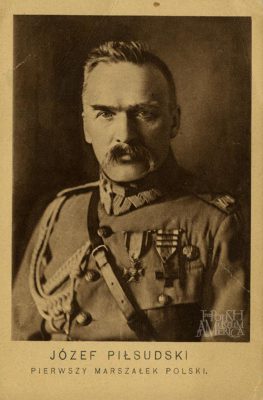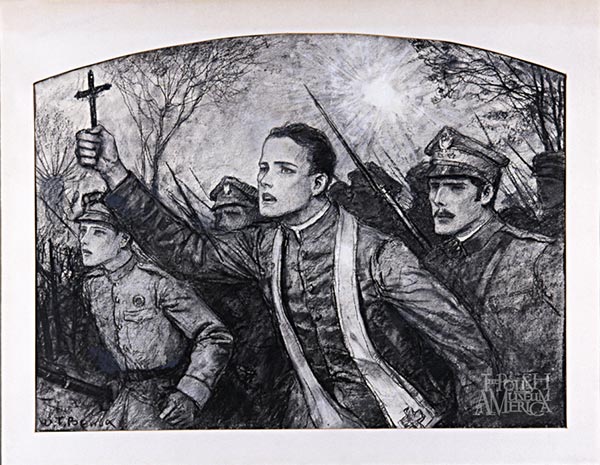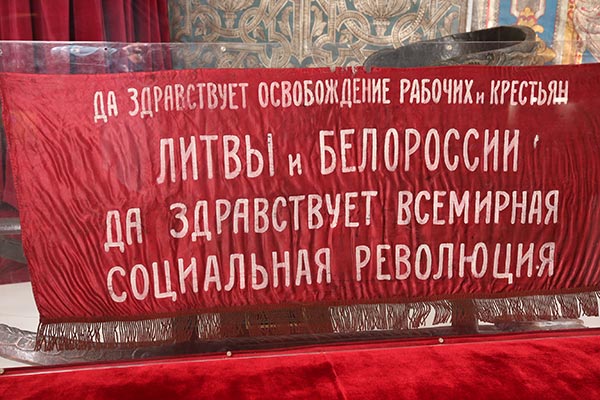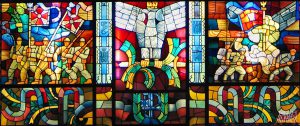The Great Victory of the Polish Armed Forces under the command of Marshal Józef Piłsudski and General Tadeusz Rozwadowski over the Bolshevik Army in the summer of 1920 stopped the Russians from occupying Western Europe all the way to the Pyrenean mountain range between France and Spain. This was the deciding confrontation during the 1919-1920 Polish-Bolshevik War, also referred to as the Polish-Soviet War or the War of 1920.
On orders of Lenin and Trotsky, two Marxist ideologues, the fire of their utopian Communist revolution was to swallow not only Poland but the entire European continent. The Bolshevik Army, led by young Marshal Mikhail Tukhachevsky, was the means to achieve this end.
 The chances for a Bolshevik victory were unusually favorable for two reasons. Europe was weak and vulnerable after the destruction and ravages of World War I. Germany, the bedrock of Communist doctrine courtesy of Marx and Engels, welcomed their new Bolshevik partner. Meanwhile, Poland had just regained its independence in November 1918 after almost 123 years of occupation and partition by three empires, the Prussians, the Austrians, and the Russians, and the devastation of World War I.
The chances for a Bolshevik victory were unusually favorable for two reasons. Europe was weak and vulnerable after the destruction and ravages of World War I. Germany, the bedrock of Communist doctrine courtesy of Marx and Engels, welcomed their new Bolshevik partner. Meanwhile, Poland had just regained its independence in November 1918 after almost 123 years of occupation and partition by three empires, the Prussians, the Austrians, and the Russians, and the devastation of World War I.
To secure Poland’s eastern peripheries, Piłsudski staged a successful military offensive reaching Kiev with his moderately refurbished armed forces. Outnumbered by the Bolsheviks and at the end of a long supply line, the Polish Army was forced to retreat westward and their situation was critical. Thus the Bolshevik revolution planners were convinced that their million man army would meet practically no opposition and have the support from the Polish workers and peasants. In this, they were fooled. The average Pole was not going to exchange one Russian master for another, no matter what banner they flew.
In moving West, the Bolsheviks were outrunning their supply lines and the Poles shortening theirs. In addition, the Poles were able to peer into the plans and actions of the Bolshevik command. Polish military cryptographers, including Józef Rybak, Karol Bołdeskuł, and Jan Kowalewski, knew Russian telegraphic and radio reconnaissance procedures. They broke enemy ciphered codes and delivered them straight to Piłsudski’s adjutants at Warsaw’s Belweder Palace.
The Polish strategy was a counter maneuver from the Wieprz River north of Warsaw, assembling a strike-force from both northern and southern fronts, with simultaneous engagement of major Bolshevik forces at the outskirts of Warsaw. The Polish assault group units covered 70 kilometers in 36 hours, splitting the Bolshevik fronts, surprising and confusing the enemy. The sacrifice of Polish soldiers could only be matched with the worldwide commitment of the volunteer army fighting together for Poland’s independence in WWI.

Władysław Benda (1873-1948) Reverend Skorupka | Ksiądz Skorupka, circa 1920 Charcoal on paper | węgiel na papierze
The Polish Museum of America has many interesting artifacts associated with these events that happened over 100 years ago. Some were brought back to America by those who served with the Blue Army when it returned to Poland from France in 1919, or were obtained later as bequests or donations.
Our large stained glass window from the Polish Pavilion at the 1939 New York World’s Fair hints at this battle at the very bottom, where the initials JP for Józef Piłsudski, his Marshal’s baton, and the Virtuti Military Cross are enclosed in a laurel wreath, the prize for victory in 1920.
This sword was given to Jan Bartmanski when he was a leader of the Polish Falcons of America prior to the entry of the United States into World War I. His family had a long history of fighting for Polish independence. His father died in the 1863 Uprising; his grandfather in the 1831 Uprising; and his great-grandfather in the Kościuszko Uprising of 1793. Jan Bartmanski was a professional soldier of the Austrian Army who came to America to make his fortune as a businessman. He retained his interest in military matters by joining the Polish Falcons in America, which regarded itself as the “Vanguard of the Nation.” He quickly rose within Falcon leadership, becoming chief instructor in 1914. In early 1917, he attended the Canadian officer training course, even though he was in his early 50s and the course was intended for men in their early 20s. He served on the Falcon Military commission before leaving for France. There he completed a logistics course and returned to Poland with the Army in early 1919. He commanded a regiment in 1920 and at the Battle of Warsaw was taken prisoner, tortured, and killed by the Russians. One of the signers of the sword, Witold Skarzynski, an American veteran from 1915 and also a Falcon officer, remained in Poland; in 1939, he was taken prisoner and murdered at Katyn.

The Polish 7th Air Escadrille, better known as the Kościuszko Squadron, partially made up of volunteers from the American Army Air Corps, played an integral role in the Polish–Bolshevik War. The exploits of Merian C. Cooper, a co-founder of the squadron, are well-documented. In 1933, Cooper earned additional fame in Hollywood, best known for writing and producing the first version of “King Kong.” Less familiar is Lt. Colonel Cedric Fauntleroy of Mississippi, who had been an early American aviator and fighter pilot. The two encouraged other demobilized American airmen to join the Polish Air Force and repay the debt owed to Poland for sending Pulaski and Kosciuszko to fight for American independence.
In 1942, Fauntleroy donated some of his militaria to the Museum and Archives of the Polish Roman Catholic Union. One item is a copy of a book written by Merian C. Cooper, “Colonel Fauntleroy and his Squadron.” This is a Polish language translation published in Chicago in 1922 by Faunt-le-Roy, Harrison & Co. The donation also included a drawing given to him as commander of the Kościuszko Squadron by the Polish non-commissioned officers during a station in Lwów in December 1919. It features the likeness of Kościuszko and is addressed to, “Our Beloved Commander, as a Souvenir of the Christmas Holyday spent in free Poland in Lwów, December 1919, the NCOs of the 7th Squadron named in honor of Kosciuszko.”
The artist depicted Polish planes flying above Lwów, which was shown as a large city with big cupolas and high towers, and thousands of buildings. Included is the Atlantic Ocean, with the Statue of Liberty on the other side, near a small village, surrounded by fields and forests. Many observers may find the humor in this unrealistic depiction of each city’s size by the soldier-artist.

The custom of war trophies collected by victors can be traced to ancient Greece and Rome. PMA collections include two such trophies from the War of 1920. The first item is a Soviet propaganda banner captured during the war. It was acquired through a donation from Lieutenant Jan Kostrubala, a graduate of Weber High School in Chicago, and a volunteer for the Polish Army in France. Despite his good Catholic upbringing, he lied about his age when he enlisted and was sent to the third officer training course in Toronto, then Camp Borden, and finally, Niagara-on-the-Lake, Ontario. Arriving in France in early 1918, he was posted to the 3rd Regiment of Riflemen. In Poland, that regiment was reorganized as the 45th Kresowy Rifles Regiment. Kostrubala engaged in many battles against the Bolsheviks, earning the Polish Cross of Valor, or Krzyż Walecznych. He was one of the last Americans to be demobilized, returning to the United States in January 1921. The Bolshevik political banner reads Greetings from the 3rd Communist International (Congress). On the reverse, it states Greetings to liberated Lithuania and Belarus! Welcome to the International Social Revolution!
This Soviet military cap was referred to as a Budienówka and was based on medieval knight’s helmets from the 12th to 13th centuries. It was donated by a Polish Army in France veteran.
World War I saw the prolific use of posters as propaganda tools, encouraging the purchase of bonds, conserving food resources, and enlisting to fight in the war. This was true of the War of 1920 as well. Much was said in this visual media and common themes were often repeated. Opposing sides presented the other as the enemy. The Bolsheviks depicted threats to the revolution from two angles: by the Whites who wanted to restore the Old Order and by the Poles who wanted to return Polish rule over the people in the borderlands. The Bolsheviks are of course handsome and strong while the Poles are shown as “Pans” -- lords with vampire fangs and wearing the traditional four-cornered caps. The Poles and Whites get their just reward by the peasant, reminding us of the guillotine during the French Revolution. The Poles paid back in kind. “Bolshevik Freedom” is portrayed by a literally Red Leon Trotsky sitting on a throne of skulls holding a knife and a pistol. Death is over his shoulder and Trotsky’s minions are stripping the bodies of the murdered.
The PMA acquired a 1920 Polish poster created by Edmund Bartlomiejczyk from the estate of Dr. Eugene Slotkowski, a Polonian activist. Entitled, “Na pomoc! Wszystko dla frontu! Wszyscy na front!” or “To Aid! Everything for the front! Everyone to the front!” this imagery is unique in that the enemy is not shown in red. The attacking mob is portrayed as a soulless horde. The only red depicted is in their banner that has a star similar to a pentagram, a sign of the devil. The two defenders are bracing the wall, reminding us of Poland’s long-standing tradition of being the defensive wall of Christendom. The artist eerily foreshadows modern zombie movies, with their theme of outnumbered humans behind some type of barrier holding back masses of soulless creatures.
One of the heroes of the defense of Warsaw was the young Polish priest, Father Ignacy Skorupka, who served as chaplain to the 236 Infantry Regiment of the Volunteer Army. According to one account, Skorupka was killed leading the young volunteers in a counter-attack. Achille Ratti, as the Vatican’s representative in Poland, was the only diplomat who remained in Warsaw during the battle. After Ratti was elevated as Pope Pius XI, he commissioned Polish artist Jan Henryk de Rosen to commemorate Skorupka’s heroic death in the mural, “Cud nad Wisłą,” at the papal summer home of Castle Gandolfo, near Rome. The PMA holds two murals by de Rosen from the 1939 New York World’s Fair Polish Pavilion. Polish and American poster artist Wladyslaw Teodor Benda created a commemorative poster depicting Father Skorupka leading the volunteers.
In 1930, Chicago’s Polonia celebrated the 10th anniversary of the victory over the Bolsheviks in grand style. Held in Humboldt Park, at the statue of Kościuszko, over 70,000 were in attendance, many of them veterans of WWI and the 1920 War. Reports from the event frequently mention Jan Kostrubala among the many veterans participating. PMA collections include a trophy awarded to the Polish Roman Catholic Union by the Society of Polish American Merchants and Industrialists, given as first prize in a contest of floats participating in the 10th Anniversary of the Miracle of the Vistula. Second prize went to St. Hedwig’s parish, and third to the Union of Polish Youth in North America, a para-military organization from the days before WWI. Also from this event is a program book and a PRCU autograph booklet with the signatures of the speakers and other figures of note.
In 1938, the museum received a memorial from the Alliance of Poles in the World to American Polonia. It was “Ground soaked by the blood of heroes, who for the Freedom and Greatness of the Nation, gave their lives.” The first soil was from Płowce, commemorating the Battle of Płowce in 1331 and the last from Radzymin, marking Battle of Radzymin in 1920. In 1999, Pope John Paul II visited the cemetery in Radzymin of the Defenders of the Fatherland, who died on the fields around Warsaw and said: “I was born in May of 1920, at a time when the Bolsheviks were advancing on Warsaw. So from my birth I am carrying this huge debt to those who at that time took up arms against the invaders and won, paying with their lives. Here in this cemetery lie their bones. I come here with great gratitude, as if to redeem what I have received from them.”
This same debt to those soldiers of 1920 should be reciprocated not only by those living in Poland, but across all Europe. One hundred years ago, there was a clash on the outskirts of Warsaw, a clash between the civilization of life and the anti-civilization of death, a struggle between Good and Evil. Good triumphed and Poles were its instrument, saving the freedom of the Old Continent. Unfortunately, that triumph was wasted as Europe experimented with the ideologies of Communism, Nazism, and Fascism. We must not forget, nor should the world!



Comments(3)
Charles Ford says:
August 19, 2022 at 1:06 pmThe Battle of Berlin fought at a similar time might have swung the other way had the Poles lost this war. Remember, Poland had been destroyed by Russia once and had not been an independent nation for almost three centuries. They were going to get no help from war-ravaged Europe and isolationist America. An amazing story.
JAN Lorys says:
August 22, 2022 at 1:59 pmAs we like to say, remember the numbers 1 2 3. there was no Poland from 1795 to 1918. (123 years). While still contracting, Poland was able to still Vienna from the Turks in 1683